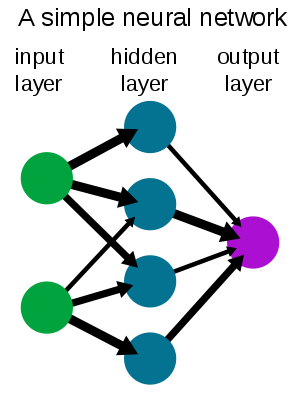Last night I was consumed with watching lessons from the online machine learning class at Stanford. The topic was neural networks, or rather the finer points of forward and back propagation.
Every time I have wanted to learn how neural networks work it just didn't click. Anyone I asked mostly just waved their hands and said that something magical happens and ... but let's start at the beginning.
The basics of neural networks is that you have neurons that are connected to other neurons. At one end you enter your input data and on the other end the neural network produces some numbers according to what it has learned. Everyone can imagine this much and it's not really difficult to visualise.
It looks like a bunch of circles with arrows:

Anyone who's studied this a tad further can tell you the connections between neurons are very important and the weights associated with them are somehow used in calculating stuff. Not a hard concept to grasp - every neuron outputs a number that is multiplied with the weight on each connection before being fed as an input into the next neuron.
Where it always got a bit hairy for me was trying to understand what do the neurons do? The most I could get out of anyone supposedly knowing this stuff is that "it calcualtes stuff". Yes but how? What does it do? What exactly?
Nobody knew.
Last night I finally figured it out! Neurons don't do anything. They don't even exist per se. In fact a neural network looks pretty damn odd inside a computer, it's really just a matrix of weights.
What happens when you're doing forward propagation (using a learned network) is simply this:
- Take the outputs from the previous layer (a vector of numbers)
- Multiply with a vector of weights (the arrows)
- Apply the cost function (this becomes the new layer)
Then you just repeat this for all the layers and that's that. That is literally all that happens.
In the end you are left with a vector of numbers representing the output layer, which you then just have to correctly interpret.
The part I don't have completely figured out yet is the backpropagation. This is the bit where neural networks learn how to do their magic. Basically backpropagations sets those weights from step 2 via a simple hill climbing algorithm ... it is essentially a way to calculate the gradient of the cost function so that you can correctly change the weights to achieve ever lower differences between what you're supposed to know and what you actually know. Eventually you hope to achieve a global minimum, but you are guaranteed to at least achieve a local minimum and not being able to tell whether it's global.
That's it. That is really all there is to it. Neural networks are just a nice way to visualise a sequence of matrix multiplications. And I guess it's easier to get grants for "neural networks" than "sequence of matrix multiplications" ...
Continue reading about I think I finally understand what a neural network is
Semantically similar articles hand-picked by GPT-4
- I suck at implementing neural networks in octave
- FANN - neural networks made easy
- First steps with Octave and machine learning
- I learned two things today 29.8.
- I learned two things today 5.8.
Learned something new?
Read more Software Engineering Lessons from Production
I write articles with real insight into the career and skills of a modern software engineer. "Raw and honest from the heart!" as one reader described them. Fueled by lessons learned over 20 years of building production code for side-projects, small businesses, and hyper growth startups. Both successful and not.
Subscribe below 👇
Software Engineering Lessons from Production
Join Swizec's Newsletter and get insightful emails 💌 on mindsets, tactics, and technical skills for your career. Real lessons from building production software. No bullshit.
"Man, love your simple writing! Yours is the only newsletter I open and only blog that I give a fuck to read & scroll till the end. And wow always take away lessons with me. Inspiring! And very relatable. 👌"
Have a burning question that you think I can answer? Hit me up on twitter and I'll do my best.
Who am I and who do I help? I'm Swizec Teller and I turn coders into engineers with "Raw and honest from the heart!" writing. No bullshit. Real insights into the career and skills of a modern software engineer.
Want to become a true senior engineer? Take ownership, have autonomy, and be a force multiplier on your team. The Senior Engineer Mindset ebook can help 👉 swizec.com/senior-mindset. These are the shifts in mindset that unlocked my career.
Curious about Serverless and the modern backend? Check out Serverless Handbook, for frontend engineers 👉 ServerlessHandbook.dev
Want to Stop copy pasting D3 examples and create data visualizations of your own? Learn how to build scalable dataviz React components your whole team can understand with React for Data Visualization
Want to get my best emails on JavaScript, React, Serverless, Fullstack Web, or Indie Hacking? Check out swizec.com/collections
Did someone amazing share this letter with you? Wonderful! You can sign up for my weekly letters for software engineers on their path to greatness, here: swizec.com/blog
Want to brush up on your modern JavaScript syntax? Check out my interactive cheatsheet: es6cheatsheet.com
By the way, just in case no one has told you it yet today: I love and appreciate you for who you are ❤️
